Summary: Immersive training helps learners practice nuanced, high-stakes procedures and interactions. Discover why immersive learning solutions are so effective, and explore three powerful use cases and applications for AR, VR, and XR learning solutions.
Examples Of Immersive Training In Action: The Learner Evolution
As workplaces, job roles, and team dynamics have evolved, so have learners‘ needs, from recalling rules and procedures to relationship-building, decision-making, and responding to complex situations. L&D leaders are increasingly embracing immersive training solutions to help learners develop these skills in a nuanced and authentic practice environment.
Learning in augmented reality (AR), virtual reality (VR), or mixed reality (MR) helps L&D leaders create more engaging, enjoyable learning experiences. (Want a crash course on the five types of reality? Check out our level-set on the metaverse and all things immersive.)
Of course, immersive learning isn’t an end in itself: It’s part of a much larger strategic conversation. (Lead the charge with these seven needs analysis steps for immersive learning.) And when you’ve got a great use case, immersive learning can be an incredibly powerful answer to your business and learning needs.
Wondering what a great immersive learning use case looks like?
You’ll find a few examples below—with names changed to protect the innovative. (Ready for the unredacted version? We name names and tell all in our eBook, Ready, Learner One? The L&D Innovator’s Gateway To Immersive Learning and the Metaverse.)
Immersive Learning: A Solution To The Experience Paradox
With some tasks, like riding a bike, the only way to learn is by doing. But unlike riding a bike, high-stakes tasks, like surgery or emergency responses, leave zero room for error.
Immersive training helps solve the paradox of needing experience to gain experience by offering a safe, authentic practice space.
Below are just a few of the benefits of offering learners that space.
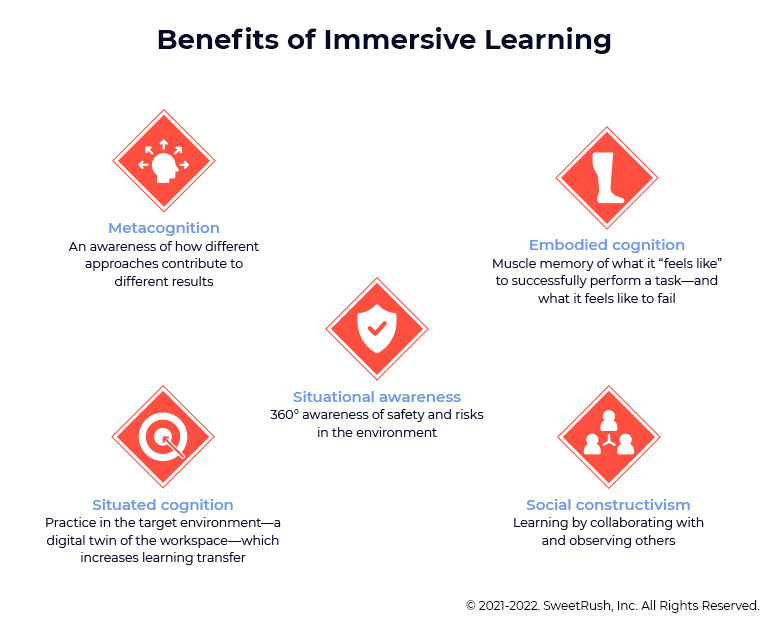
Immersive Learning Use Cases
Immersive Learning Use Case 1: Interpersonal Skills
Your learners need to practice nuanced, spontaneous interpersonal skills, like empathy and de-escalation, without harming real humans.
The Skills: Metacognition, embodied cognition

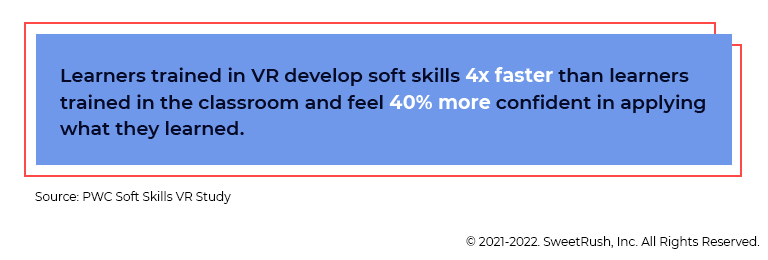
Learning Need: Empathy And Relationship Building
SweetRush’s Immersive Learning team partnered with a global hotel chain that hires thousands of new corporate team members every year, few of whom have hands-on experience working in hotels. Leadership wanted these new hires to gain empathy for the hotel team members whose lives are touched by the rules and policies these new corporate team members will create.
The SweetRush-client team brought the hotel to the new team members with a VR training experience that includes a hotel tour and three hands-on operational tasks: setting up room service trays, checking in guests, and cleaning guestrooms.
Here’s how that went:
- 94% of participants said that the training experience increased their empathy for hotel team members.
- 75% of participants reported that the experience improved their problem-solving and customer service skills.[2]
Learning Need: Conflict Resolution And De-escalation
73% of the nearly 25,000 workplace assaults reported annually take place in health care facilities.[3]
25% of nurses report being physically assaulted by a patient or a patient’s family member.[4]
A nonprofit network of hospitals and outpatient care centers wanted to protect its family of 45,000 health care providers by training them to identify and de-escalate dangerous patient situations—without actually placing the health care providers in danger.
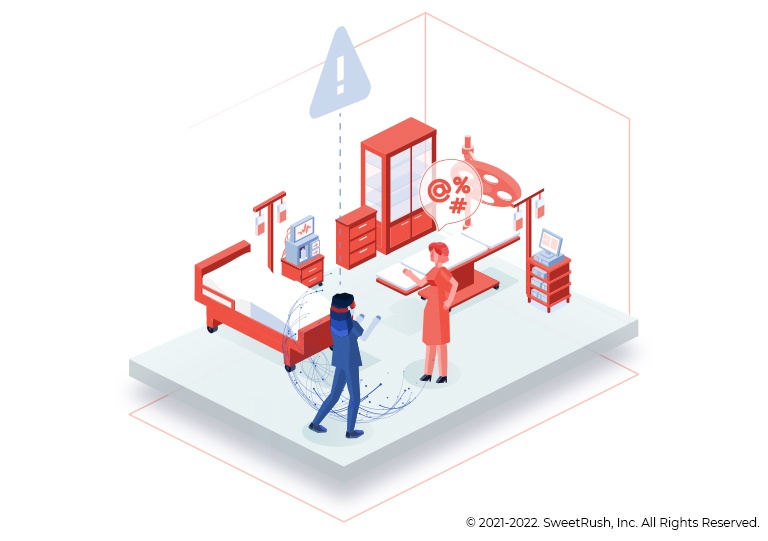
This client joined forces with SweetRush to create a VR experience based in the familiar hospital setting. Learners follow the sound of shouting to a patient’s room—and are greeted with abusive language when they enter.
Learners must defuse the situation using their words, tone of voice, and gestures. If they’re successful, the patient calms down; if not, the patient escalates. Voice recognition and body movement tracking data help learners review and learn from missteps.
Why Traditional Role-Plays Don’t Work for De-Escalation Training
Without backstory or context (or professional actors!), it’s impossible to replicate certain situations or suspend disbelief.[2] For de-escalation training to be successful, learners need emotional immediacy, immersion, and a safe, authentic space to practice their emerging skills.
“It makes sense to use immersion if the lesson has an interactive or kinesthetic component such as learning how to handle hazardous equipment, or how to perform a specific surgery. These lessons are difficult to teach via basic book learning or other symbolic methods. Being within the environment … is a much more intuitive human situation.” —Jacquelyn F. Morie, scientist, author, and educator[5]
Immersive Learning Use Case 2: Hands-On And High-Stakes Procedures
Your learners need hands-on practice to master high-stakes procedures such as surgery, equipment repair, or emergency responses—without risking damage to people or property.
The Skills: Metacognition, embodied cognition, situational awareness, and situated cognition

Learning Need: Emergency Responses
A leading automotive company wanted sales associates to experience how its new tire technology can literally save lives. They partnered with SweetRush to create a VR experience that places learners on the open road. Trucks rush toward them on a rainy highway—and stop on a dime, thanks to the powerful features of the tires. The heart-pounding experience gives learners a story to tell and keeps product benefits at top of mind.
Learning Need: Surgery And Other Medical Procedures
Hospitals are increasingly leveraging XR to train staff in the use of lifesaving equipment and procedures.[6] During the COVID-19 pandemic, Sheba Medical Center used a wearable AR solution to train staff to use ventilators.[7] This hardware also helped doctors assist remotely in inpatient care.
The Imperial College of London used a VR solution to train surgeons—and discovered that 83% of learners were ready to perform procedures with little guidance after training—compared with a staggering 0% using traditional methods.[8]
Miami Children’s Hospital found that medical staff who learned new procedures in an immersive environment had an 80% retention rate one year later—compared to 20% one week later using traditional methods.[9]
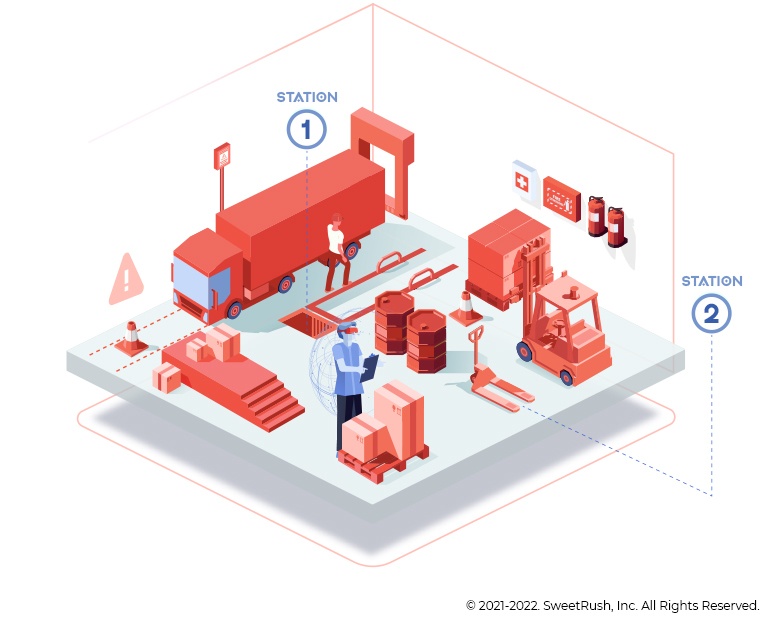
Learning Need: Handling Hazardous Materials And Equipment
A leading transportation company wanted to recreate a rigorous garage safety class in its new manager training program as a gamified VR experience. They joined forces with SweetRush’s Immersive Learning team to build a 3D garage full of safety risks. Learners must work against the clock to identify and prioritize the hazards. The results? All learners developed a keen eye for safety risks.
Immersive Learning Use Case 3: Live Collaboration And Learning
You want to re-engage your screen-fatigued team members in a “third space” for live collaboration and learning.
The Skills: Embodied cognition, social constructivism

SweetRushians John Cleave, Senior Learning Engineer, and Emily Dale, Learning Architect, explain why traditional video meetings can feel exhausting: When we have more than about five people in a meeting, speaking turns into a lecture—and breakout rooms usually aren’t spontaneous or conducive to mingling.[10]
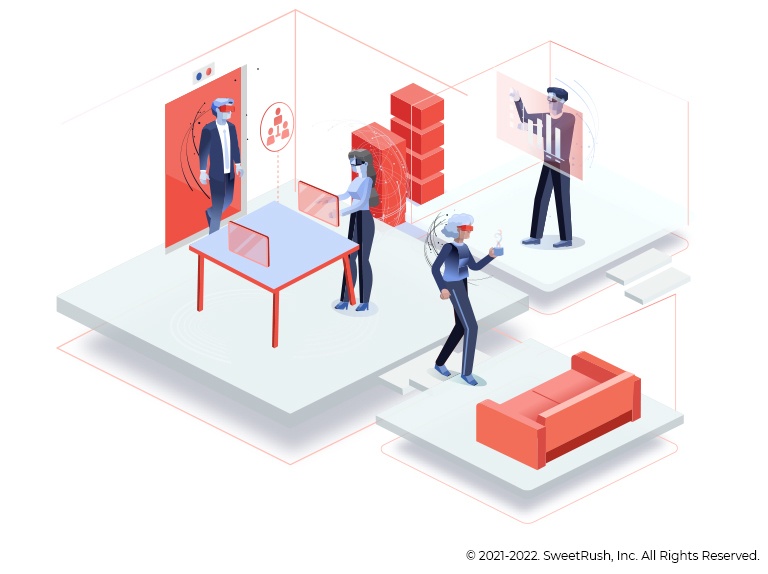
Multiuser environments like SweetRush’s Treehouse (VR) or Microsoft Mesh[11] (AR and/or VR) can restore the “many-on-many” sense of being together in real time.[12] Inside these XR “third spaces,” we can whiteboard, brainstorm, prototype, and workshop—and enjoy a break from our everyday workspaces.
Best of all, these environments allow us to enjoy the simultaneous one-on-one or small group interactions that are critical to face-to-face collaboration. Immersive experiences allow us to mingle naturally with others and even tinker with objects in our environment. As we do so, we see more of each other’s unique personalities (dare we say quirks?), whether it’s CEO Andrei Hedstrom using objects in the space to make art or SweetRush team members bouncing off the walls of the Treehouse.
XR third spaces aren’t just for goofing off: They also allow us to get curious about what our peers are doing, tag along, and learn from them. See below for one of our favorite live, synchronous, VR training solutions.
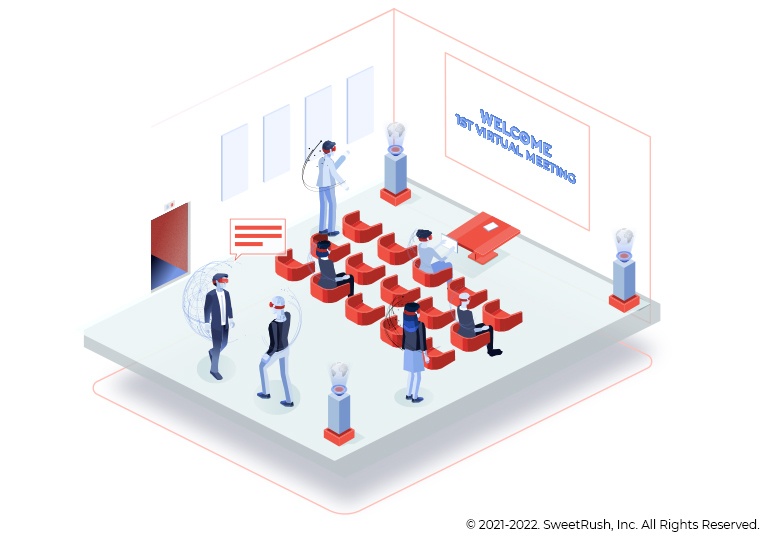
Craving a LIve Training Experience? Try Virtual Reality Instructor-Led Training (VR-ILT)!
Can you imagine cleaning up a chemical spill, de-escalating an angry customer, or putting out fires… at an instructor-led training? It’s all possible—with VR.
VR-ILT not only brings us together for the live learning experiences we’ve been missing. It also provides immediate opportunities to practice new skills. In VR-ILT, the instructor has the ability to control variables in the environment and use real-time data to differentiate instruction for every learner. These data also show when learners have reached proficiency and when they need reinforcement and remediation.
Sound exciting? Adrian Soto, SweetRush Director of Immersive Technologies, shares, “Current technology provides a space for instructors and learners to connect remotely and in real time within the same virtual environment. We know VR-ILT will benefit L&D and provide an additional tool to create engaging learning experiences.”
Immersive Learning: The Next Evolution Of L&D
As you can see from these three use cases—and the diverse learning needs they serve—immersive learning is the next evolution of the L&D practices you’re already getting right.
Here are just a few:
- Spaced repetition, or presenting learning content over increasingly longer time intervals, and presenting challenging content more often to help learners develop proficiency
- Microlearning, or learning in hyper-effective short bursts that respect the learner’s schedule and maximize retention
- Gamification, or learning experiences in the form of exciting individual or group challenges that reward learners as they apply and hone target skills
- Storytelling, or learning in narrative form, that invites learners to apply target skills as they choose their own adventure and follow the ups and downs of their decisions
If learning in XR still feels like a plunge into the unknown, I’d encourage you not to worry about the technology! Like any learning technology, you can get as detailed as you need (or want!), depending on whether your role is strategic or hands-on. And you’ve got a village to lean on: Your vendor-partner, stakeholders, and leaders are all in it with you as you explore opportunities to skill, connect, and collaborate in XR. (Ready to meet your perfect-match vendor-partner? Jump to our checklist for guidance.)
Initiate Immersion: Human-Centered Training In The Metaverse and Beyond
We’ve said it before: It’s all about your people[13]—and the organization that brings you together around a craft you care about. XR technology should make it easier for your team to be human, together. To paraphrase the great usability expert Don Norman, technology should serve your people: not the other way around.[14]
Like so many human-centered practices, immersive learning also serves your business. The more learners you serve with your immersive solutions, the greater the return on your training investment: A recent study by PwC found that VR training is more cost-effective at scale than traditional classroom and eLearning experiences.[1]
For more on XR use cases and imaginative immersive solutions, check out our eBook, Ready, Learner One? The L&D Innovator’s Gateway To Immersive Learning and the Metaverse. You’ll find plenty of inspiration to help you create an immersive learning strategy that lifts up your people and your business.
References
- What does virtual reality and the metaverse mean for training?
- Unleash the potential of VR training
- Rising violence in health care: How employers can take control
- Physical and verbal violence against health care workers
- Jacquelyn F. Morie, “The Promises and Challenges of Immersive Education,” Handbook of Research on the Global Impacts and Roles of Immersive Media (Hershey, PA: IGI Global, 2020), pp. 349–370.
- Here’s why hospitals are using virtual reality to train staff
- WEARABLE AUGMENTED REALITY TECHNOLOGY USED AT SHEBA FOR TEACHING MEDICAL STAFF
- Johnson & Johnson wants to bring VR to doctors-in-training worldwide
- Virtual reality for medical training: How it benefits hospitals
- A Mission to Make Virtual Parties Actually Fun
- Microsoft Mesh hands-on demo | New platform to deliver collaborative mixed reality experiences
- The Metaverse Value-Chain
- Embracing Human-Centered Business, Workplace Culture, and Learning Design
- Donald A. Noman, Things That Make Us Smart: Defending Human Attributes in the Age of the Machine, 1993, Reading, Mass: Addison-Wesley Pub. Co.
Quelle:
https://elearningindustry.com/immersive-learning-not-so-curious-use-cases-for-immersive-learning
Foto: Manuel Hidalgo/SweetRush



